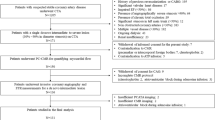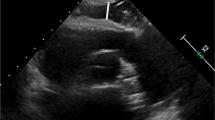Abstract
Systemic low-grade inflammation has been shown to be associated with left ventricular hypertrophy (LVH). However, the relationship between pericoronary adipose tissue attenuation (PCATA) and both LVH and regional physiological indices remains unknown. This study aimed to evaluate the association of PCATA with LVH and regional physiological indices in stable coronary artery disease (CAD) patients with preserved systolic function. A total of 114 CAD patients who underwent coronary CT angiography (CTA) and invasive physiological tests showing ischemia due to a single de novo lesion were included in the study. On proximal 40-mm segments of all three major coronary vessels on CTA, PCATA was assessed by the crude analysis of the mean CT attenuation value [− 190 to − 30 Hounsfield units [HU)] and the culprit vessel PCATA was used for the analysis. Regional physiological indices were invasively obtained by pressure–temperature sensor-tipped wire. The patients were divided into three groups by culprit vessel PCATA tertiles, and clinical, CTA-derived, and physiological indices were compared. Univariable and multivariable analyses were further performed to determine the predictors of LVH. Angiographic stenosis severity, culprit lesion locations, culprit vessel fractional flow reserve, coronary flow reserve, index of microcirculatory resistance, total and target vessel coronary calcium score, and biomarkers including high-sensitivity C-reactive protein were not different among the groups. The left ventricular (LV) mass, LV mass index (LVMI), and LV mass at risk were all significantly different in the three groups with the greatest values in the highest tertile group (all, P < 0.05). On multivariable analysis, male gender, NT-proBNP, and PCATA were independent predictors of LVMI. Culprit vessel PCATA was significantly associated with LVMI, but not with regional physiology in CAD patients with functionally significant lesions and preserved systolic function. Our results may offer insight into the pathophysiological mechanisms linking pericoronary inflammation and LVH to worse prognosis.






Similar content being viewed by others
References
Hansson GK (2005) Inflammation, atherosclerosis, and coronary artery disease. N Engl J Med 352:1685–1695
Hansson GK, Libby P, Tabas I (2015) Inflammation and plaque vulnerability. J Intern Med 278:483–493
Ross R (1999) Atherosclerosis is an inflammatory disease. Am Heart J 138:S419–420
Ridker PM, Everett BM, Thuren T, MacFadyen JG, Chang WH, Ballantyne C, Fonseca F, Nicolau J, Koenig W, Anker SD, Kastelein JJP, Cornel JH, Pais P, Pella D, Genest J, Cifkova R, Lorenzatti A, Forster T, Kobalava Z, Vida-Simiti L, Flather M, Shimokawa H, Ogawa H, Dellborg M, Rossi PRF, Troquay RPT, Libby P, Glynn RJ, Group CT (2017) Antiinflammatory therapy with canakinumab for atherosclerotic disease. N Engl J Med 377:1119–1131
Oikonomou EK, Marwan M, Desai MY, Mancio J, Alashi A, Hutt Centeno E, Thomas S, Herdman L, Kotanidis CP, Thomas KE, Griffin BP, Flamm SD, Antonopoulos AS, Shirodaria C, Sabharwal N, Deanfield J, Neubauer S, Hopewell JC, Channon KM, Achenbach S, Antoniades C (2018) Non-invasive detection of coronary inflammation using computed tomography and prediction of residual cardiovascular risk (the CRISP CT study): a post-hoc analysis of prospective outcome data. Lancet 392:929–939
Antonopoulos AS, Sanna F, Sabharwal N, Thomas S, Oikonomou EK, Herdman L, Margaritis M, Shirodaria C, Kampoli AM, Akoumianakis I, Petrou M, Sayeed R, Krasopoulos G, Psarros C, Ciccone P, Brophy CM, Digby J, Kelion A, Uberoi R, Anthony S, Alexopoulos N, Tousoulis D, Achenbach S, Neubauer S, Channon KM, Antoniades C (2017) Detecting human coronary inflammation by imaging perivascular fat. Sci Transl Med 9:eaal2658
Verdecchia P, Carini G, Circo A, Dovellini E, Giovannini E, Lombardo M, Solinas P, Gorini M, Maggioni AP, Group MS (2001) Left ventricular mass and cardiovascular morbidity in essential hypertension: the MAVI study. J Am Coll Cardiol 38:1829–1835
Levy D, Garrison RJ, Savage DD, Kannel WB, Castelli WP (1990) Prognostic implications of echocardiographically determined left ventricular mass in the Framingham Heart Study. N Engl J Med 322:1561–1566
Mehta SK, Rame JE, Khera A, Murphy SA, Canham RM, Peshock RM, de Lemos JA, Drazner MH (2007) Left ventricular hypertrophy, subclinical atherosclerosis, and inflammation. Hypertension 49:1385–1391
Johnson NP, Toth GG, Lai D, Zhu H, Acar G, Agostoni P, Appelman Y, Arslan F, Barbato E, Chen SL, Di Serafino L, Dominguez-Franco AJ, Dupouy P, Esen AM, Esen OB, Hamilos M, Iwasaki K, Jensen LO, Jimenez-Navarro MF, Katritsis DG, Kocaman SA, Koo BK, Lopez-Palop R, Lorin JD, Miller LH, Muller O, Nam CW, Oud N, Puymirat E, Rieber J, Rioufol G, Rodes-Cabau J, Sedlis SP, Takeishi Y, Tonino PA, Van Belle E, Verna E, Werner GS, Fearon WF, Pijls NH, De Bruyne B, Gould KL (2014) Prognostic value of fractional flow reserve: linking physiologic severity to clinical outcomes. J Am Coll Cardiol 64:1641–1654
Muntner P, Shimbo D, Carey RM, Charleston JB, Gaillard T, Misra S, Myers MG, Ogedegbe G, Schwartz JE, Townsend RR, Urbina EM, Viera AJ, White WB, Wright JT Jr (2019) Measurement of blood pressure in humans: a scientific statement from the American Heart Association. Hypertension 73:e35–e66
Fearon WF, Balsam LB, Farouque HM, Caffarelli AD, Robbins RC, Fitzgerald PJ, Yock PG, Yeung AC (2003) Novel index for invasively assessing the coronary microcirculation. Circulation 107:3129–3132
De Bruyne B, Pijls NH, Smith L, Wievegg M, Heyndrickx GR (2001) Coronary thermodilution to assess flow reserve: experimental validation. Circulation 104:2003–2006
Yong AS, Layland J, Fearon WF, Ho M, Shah MG, Daniels D, Whitbourn R, Macisaac A, Kritharides L, Wilson A, Ng MK (2013) Calculation of the index of microcirculatory resistance without coronary wedge pressure measurement in the presence of epicardial stenosis. JACC Cardiovasc Interv 6:53–58
Wakasa N, Kuramochi T, Mihashi N, Terada N, Kanaji Y, Murai T, Lee T, Yonetsu T, Kobashi K, Miyamoto K, Tobata H, Kakuta T (2016) Impact of pressure signal drift on fractional flow reserve-based decision-making for patients with intermediate coronary artery stenosis. Circ J 80:1812–1819
Abbara S, Blanke P, Maroules CD, Cheezum M, Choi AD, Han BK, Marwan M, Naoum C, Norgaard BL, Rubinshtein R, Schoenhagen P, Villines T, Leipsic J (2016) SCCT guidelines for the performance and acquisition of coronary computed tomographic angiography: a report of the society of cardiovascular computed tomography guidelines committee: endorsed by the North American Society for Cardiovascular Imaging (NASCI). J Cardiovasc Comput Tomogr 10:435–449
Fuchs A, Mejdahl MR, Kuhl JT, Stisen ZR, Nilsson EJ, Kober LV, Nordestgaard BG, Kofoed KF (2016) Normal values of left ventricular mass and cardiac chamber volumes assessed by 320-detector computed tomography angiography in the Copenhagen General Population Study. Eur Heart J Cardiovasc Imaging 17:1009–1017
Klein R, Ametepe ES, Yam Y, Dwivedi G, Chow BJ (2017) Cardiac CT assessment of left ventricular mass in mid-diastasis and its prognostic value. Eur Heart J Cardiovasc Imaging 18:95–102
Mao SS, Li D, Rosenthal DG, Cerilles M, Zeb I, Wu H, Flores F, Gao Y, Budoff MJ (2013) Dual-standard reference values of left ventricular volumetric parameters by multidetector CT angiography. J Cardiovasc Comput Tomogr 7:234–240
Fuchs A, Kuhl JT, Lonborg J, Engstrom T, Vejlstrup N, Kober L, Kofoed KF (2012) Automated assessment of heart chamber volumes and function in patients with previous myocardial infarction using multidetector computed tomography. J Cardiovasc Comput Tomogr 6:325–334
Kang SJ, Yang DH, Kweon J, Kim YH, Lee JG, Jung J, Kim N, Mintz GS, Kang JW, Lim TH, Park SW (2016) Better diagnosis of functionally significant intermediate sized narrowings using intravascular ultrasound-minimal lumen area and coronary computed tomographic angiography-based myocardial segmentation. Am J Cardiol 117:1282–1288
Juneau D, Erthal F, Clarkin O, Alzahrani A, Alenazy A, Hossain A, Inacio JR, Dwivedi G, Dick AJ, Rybicki FJ, Chow BJ (2017) Mid-diastolic left ventricular volume and mass: normal values for coronary computed tomography angiography. J Cardiovasc Comput Tomogr 11:135–140
Devereux RB, Wachtell K, Gerdts E, Boman K, Nieminen MS, Papademetriou V, Rokkedal J, Harris K, Aurup P, Dahlof B (2004) Prognostic significance of left ventricular mass change during treatment of hypertension. JAMA 292:2350–2356
Vakili BA, Okin PM, Devereux RB (2001) Prognostic implications of left ventricular hypertrophy. Am Heart J 141:334–341
Chambers J (1995) Left ventricular hypertrophy. BMJ 311:273–274
Sullivan JM, Vander Zwaag RV, El-Zeky F, Ramanathan KB, Mirvis DM (1993) Left ventricular hypertrophy: effect on survival. J Am Coll Cardiol 22:508–513
Bo S, Mandrile C, Milanesio N, Pagani A, Gentile L, Gambino R, Villois P, Ghinamo L, Canil S, Durazzo M, Cassader M, Cavallo-Perin P (2012) Is left ventricular hypertrophy a low-level inflammatory state? A population-based cohort study. Nutr Metab Cardiovasc Dis 22:668–676
Tsioufis C, Stougiannos P, Kakkavas A, Toutouza M, Mariolis A, Vlasseros I, Stefanadis C, Kallikazaros I (2005) Relation of left ventricular concentric remodeling to levels of C-reactive protein and serum amyloid A in patients with essential hypertension. Am J Cardiol 96:252–256
Turiel M, Atzeni F, Tomasoni L, de Portu S, Delfino L, Bodini BD, Longhi M, Sitia S, Bianchi M, Ferrario P, Doria A, De Gennaro CV, Sarzi-Puttini P (2009) Non-invasive assessment of coronary flow reserve and ADMA levels: a case-control study of early rheumatoid arthritis patients. Rheumatology (Oxford) 48:834–839
Teragawa H, Fukuda Y, Matsuda K, Ueda K, Higashi Y, Oshima T, Yoshizumi M, Chayama K (2004) Relation between C reactive protein concentrations and coronary microvascular endothelial function. Heart 90:750–754
Vaccarino V, Khan D, Votaw J, Faber T, Veledar E, Jones DP, Goldberg J, Raggi P, Quyyumi AA, Bremner JD (2011) Inflammation is related to coronary flow reserve detected by positron emission tomography in asymptomatic male twins. J Am Coll Cardiol 57:1271–1279
van de Hoef TP, Echavarria-Pinto M, van Lavieren MA, Meuwissen M, Serruys PW, Tijssen JG, Pocock SJ, Escaned J, Piek JJ (2015) Diagnostic and prognostic implications of coronary flow capacity: a comprehensive cross-modality physiological concept in ischemic heart disease. JACC Cardiovasc Interv 8:1670–1680
Johnson NP, Kirkeeide RL, Gould KL (2012) Is discordance of coronary flow reserve and fractional flow reserve due to methodology or clinically relevant coronary pathophysiology? JACC Cardiovasc Imaging 5:193–202
Ehara S, Shirai N, Okuyama T, Matsumoto K, Matsumura Y, Yoshiyama M (2011) Absence of left ventricular concentric hypertrophy: a prerequisite for zero coronary calcium score. Heart Vessels 26:487–494
Tahara N, Imaizumi T, Virmani R, Narula J (2009) Clinical feasibility of molecular imaging of plaque inflammation in atherosclerosis. J Nucl Med 50:331–334
Ge CJ, Lu SZ, Chen YD, Wu XF, Hu SJ, Ji Y (2008) Synergistic effect of amlodipine and atorvastatin on blood pressure, left ventricular remodeling, and C-reactive protein in hypertensive patients with primary hypercholesterolemia. Heart Vessels 23:91–95
Author information
Authors and Affiliations
Corresponding author
Additional information
Publisher's Note
Springer Nature remains neutral with regard to jurisdictional claims in published maps and institutional affiliations.
Electronic supplementary material
Below is the link to the electronic supplementary material.
Rights and permissions
About this article
Cite this article
Hirano, H., Kanaji, Y., Sugiyama, T. et al. Impact of pericoronary adipose tissue inflammation on left ventricular hypertrophy and regional physiological indices in stable coronary artery disease patients with preserved systolic function. Heart Vessels 36, 24–37 (2021). https://doi.org/10.1007/s00380-020-01658-1
Received:
Accepted:
Published:
Issue Date:
DOI: https://doi.org/10.1007/s00380-020-01658-1




